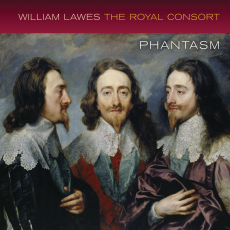Phantasm - Lawes: The Royal Consort - MusicWeb International
The brothers William and Henry Lawes were among the foremost musicians of the early seventeenth century. Henry composed the music for Milton's Comus and was the recipient of one of his sonnets. Had William, a staunch Royalist supporter in the English Civil War, not died young at the Siege of Chester, we might well be remembering him alongside Purcell as one of the century's greatest musicians.
[You may want to] explore
Lawes' music further, in which case you would be well served by both the
Chandos and Linn recordings. Actually they are not strictly comparable: the
Chandos features the revised six-part consorts whereas the Linn employs the
earlier, leaner four viols plus theorbo scoring which Laurence Dreyfus claims
in the notes as greatly superior.
The other difference is that whereas Chandos offer
just the ten Setts of the Royal Consort in numerical order, Linn vary the order
and include three other works, including three Setts to the Organ which could
not be included in their very fine earlier CD of Lawes' music (CKD399:
Recording of the Month - review and DL Roundup
July 12/2).
I've already mentioned Laurence Dreyfus's notes
for his categorical statement that the six-part scoring with violins spoils the
textures of these works. That's not the only controversial assertion: at the
outset he nails his colours to the mast in defying Dr. Burney's description of
this music as dull, asserting it as ‘one of the greatest collections of
ensemble dance music ever composed' alongside Dowland's Lachrimæ, Rameau's ballets, Bach's Suites and the music of Johann
Strauss II. I'm not sure that I go along entirely with either of these
assertions: though I greatly enjoyed the music as his group presents it.
This is very
enjoyable and varied music. Both ensembles bring out the sheer delight of the
various movements and though the 4-viol version theoretically brings greater
clarity. The new Phantasm recording makes the music sound not sparer
but fuller in tone. I'm no shakes as a dancer but both recordings make me want
to skip along without making the music sound at all facile.
It's not possible to do an exact like-for-like
comparison because Lawes added extra bars and whole extra movements to the
six-part versions: Sett No.1, for example, which runs to 6:47 on Linn is 12:15
on Chandos. That also means that the difference in playing time is less than
you might expect, despite the addition of four other works on Linn.
Both are well recorded. The Linn scores by its
availability in 24-bit sound - 24/192 even, and on SACD. In the past when I have been able to compare the HD stereo tracks
on a Linn SACD with the 24/96 download I have found no discernable difference
between the two.
Controversial assertions notwithstanding, I found
Dreyfus's 14 pages of notes very informative. Bruce Wood's notes in the Chandos
booklet are shorter but also very valuable.
This is a case of paying your money and taking
your pick. Unfortunately I can't point you to a way of comparing the two. If
you subscribe to the very valuable Naxos Music Library, you'll find the Linn,
but not the Chandos, there - but don't be tempted to press the iTunes purchase
button when you will find better quality downloads from Hyperion and Linn.
If you follow my advice to obtain one of these
recordings of the Royal Consort music you may well be looking for more music by
William Lawes. An obvious choice would be the earlier Linn recording of the
Setts to the Organ which I've mentioned.


